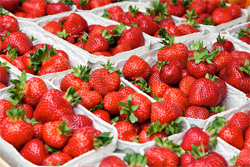In May and June, fresh strawberries pack the shelves in grocery stores. However, what if you want strawberries year-round without paying a premium price? You can grow and preserve strawberries yourself. Getting started with strawberries is one of the easiest fruits to add to your garden. An adventure worth taking.
June-Bearing Strawberries
 image: Wikimedia Commons
image: Wikimedia Commons
Since so many berries ripen at once, the fruit from June-bearing plants is often used for jams, jellies, and other preserves. Canning isn't as difficult as many think, and starting with an acidic product, such as strawberry jam, simplifies the process even further.
Everbearing Strawberries
Although many people feel the June-bearing varieties are the best, everbearing plants also produce sweet, juicy berries. Since they produce from spring through fall, you need to pay a little extra attention to watering and fertilizing. Like all strawberries, everbearing varieties need slightly acidic soil, with a pH of 5.5 to 6.5. Adding well-rotted manure, peat moss, or compost will help maintain an acidic ph while also adding nutrients.
Most everbearing varieties send out few or no runners. Therefore, they can be planted 12 inches apart in a garden, or 8 inches apart in a container. Containers placed in a sunny location in a convenient spot for watering, fertilizing, and picking, can help ensure you enjoy every berry.
Alpine Strawberries
 Tiny alpine strawberries have
Tiny alpine strawberries havea different flavor
than cultivated strawberries.
On very rare occasions, strawberries may not bloom. A handful of Epsom salts sprinkled onto the soil should prompt them to flower. As with many blooming plants, a lack of magnesium can prevent flowering. Since Epsom salts are mainly magnesium and are highly soluble, sprinkling it on soil just before watering should provide what the plants need.
The Best Strawberry Fertilizer
Strawberries need nitrogen, phosphorus, and potassium. Therefore, fertilizer should contribute these nutrients. In addition, since you're going to be picking the berries for eating, you don't want to use a fertilizer that's combined with pesticides or other toxic chemicals.
Compost, preferably organic, is generally regarded as the best fertilizer for just about any plant, including strawberries. There are many ways to make compost, but the basics are that you need "brown" matter, such as dead leaves or well-rotted manure. You also need "green" matter, such as grass clippings. Vegetable waste from the kitchen can also add valuable nutrients. Apple and potato peels, the ends of carrots or celery, or just about any fresh vegetable can be added. Eggshells add calcium and other minerals. However, do not add any meat or milk products, as they will make the compost "sour" and encourage the growth of bacteria that are detrimental to plants. In addition, do not add anything from onions, scallions, or garlic. These foods can prohibit the growth of strawberries, as well as other plants.
Manure adds nitrogen, potassium, and phosphorous to compost. Always use old manure. Fresh manure can damage the plants with too much nitrogen, causing the plants to either not flower, or to produce soft, mushy fruit. In addition, fresh manure can contain worms (the intestinal parasite kind), E. coli, and other organisms that are harmful to people. Chicken manure can also contain Salmonella. Always wash and disinfect your hands after handling manure, and always wash berries before eating them.
Fish emulsion can also be used to fertilize plants. If your strawberry plants are light green in color, and just don't look healthy, the high nitrogen content of fish emulsion may help. Fish waste can be dissolved in water and sprayed directly on the plants until they are dripping. Incidentally, fish emulsion can help keep deer away from the strawberry patch.
So which variety of strawberry is best for you? Why not try planting all three and find out?